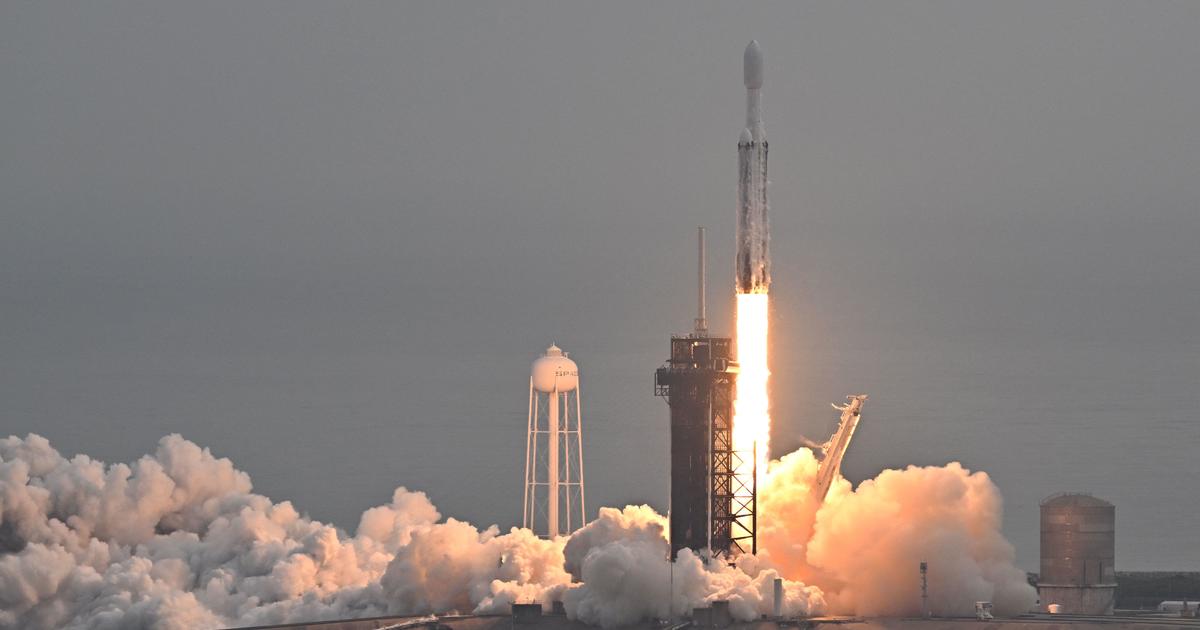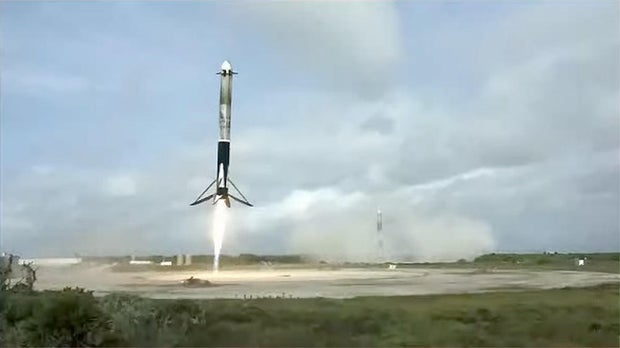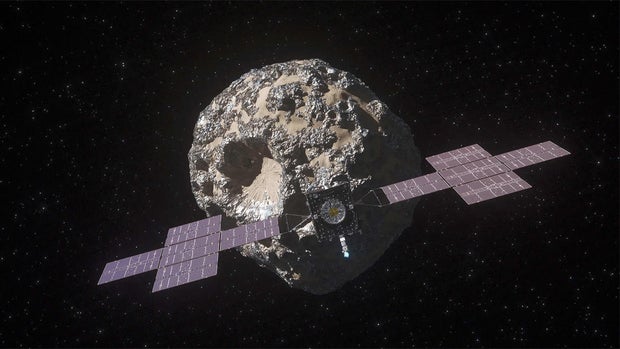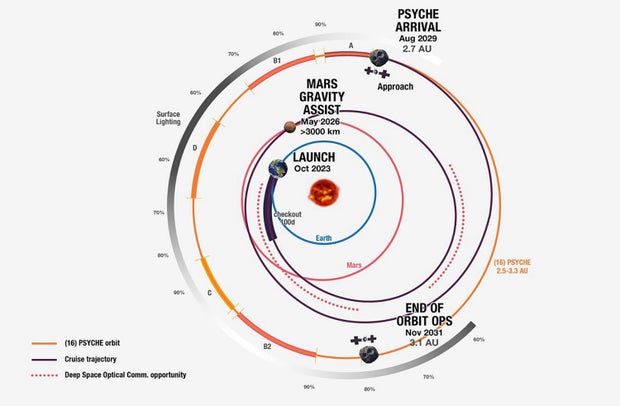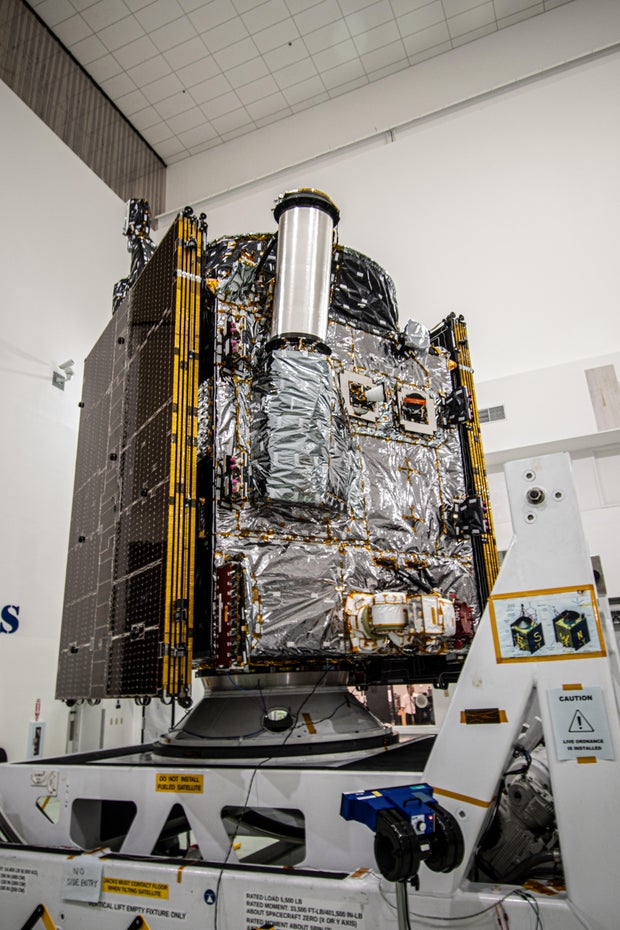[ad_1]
Getting off to a ground-shaking begin, NASA’s $1.2 billion Psyche asteroid probe roared into house atop a Falcon Heavy rocket Friday, setting off on a 2.2-billion-mile voyage to a uncommon, metal-rich asteroid which will maintain clues about how the cores of rocky planets like Earth first shaped.
“We’ll study a beforehand unstudied ingredient that went into making our liveable Earth, and that’s the steel that’s now within the Earth’s core and the cores of the entire rocky planets, cores that we will by no means go to however in fact that we need to study,” stated principal investigator Lindy Elkins-Tanton.
“And Psyche is the only largest metallic object in our photo voltaic system. So if we need to study our cores, that is the place we have to go.”
CHANDAN KHANNA/AFP through Getty Photos
Following a number of setbacks and delays within the wake of the COVID pandemic — and a remaining 24-hour slip as a result of stormy climate Thursday — the Psyche mission lastly received underneath approach at 10:19 a.m. EDT when the SpaceX Falcon Heavy’s 27 first-stage engines ignited with a thundering rush of flaming exhaust.
After a remaining spherical of pc checks, the 230-foot-tall rocket was launched from historic pad 39A on the Kennedy House Middle, easily climbing away atop greater than 5 million kilos of thrust.
The Falcon Heavy’s two strap-on aspect boosters shut down and peeled away two-and-a-half minutes after liftoff and flew again to staggered side-by-side landings on the Cape Canaveral House Pressure Station. The expendable central core booster continued firing one other minute and a half earlier than it, too, fell away.
NASA
The one engine powering the rocket’s second stage then took over the climb to house. After a 45-minute coast, the engine fired a second time, placing the car on the required Earth-escape trajectory. The 6,000-pound Psyche probe was launched to fly by itself six minutes later, kicking off a six-year voyage to the asteroid it was named after.
Found in 1852 by the Italian astronomer Annibale de Gasparis, 16 Psyche is the biggest of 9 identified metal-rich asteroids, orbiting within the outer asteroid belt between Mars and Jupiter 3 times farther from the solar than Earth.
Radar observations present it is formed roughly like a potato, measuring 173 miles throughout and 144 miles lengthy, but it surely solely seems as a star-like dot in even probably the most highly effective telescopes. Scientist know from spectral and different observations that its steel content material is excessive.
“We’re fairly assured that it’s largely made from steel together with one thing else,” stated Elkins-Tanton. “That is one thing else may be rock, it may be sulfur based mostly and it may be carbon based mostly. We do not know. And that’s actually the joy of this.”
NASA
Earlier within the mission, a reporter requested her how a lot an asteroid like Psyche may be price given its excessive steel content material. The numbers ranged as excessive as $10 quintillion.
“It is my fault, as a result of I did try this calculation,” Elkins-Tanton stated. “It makes such an incredible headline. However it’s false in each approach. We have now zero know-how to carry Psyche again to Earth. And if we did, it might doubtless be a catastrophic mistake. It could flood the metals market and it might actually be price nothing. And so calculating the worth of it (is) a enjoyable mental train with no fact to it.”
Likewise, an artist’s impression of the asteroid, based mostly on steerage from Elkins-Tanton and the newest occupied with remnant planetary cores. Whereas the picture is “believable for what we suspect,” she stated, it is “not actual, as a result of we do not know what it seems like.”
Or the way it shaped within the first place. There are two main theories.
“One is that it is a core of a physique, analogous to love what’s contained in the Earth, with a molten metallic middle,” stated Ben Weiss, Psyche deputy principal investigator at MIT. “However on this case, Psyche had its outer layers stripped off by asteroid impacts within the early photo voltaic system, so we will see (the uncovered core) right now.
“The opposite concept is that Psyche is a sort of primordial, unmelted physique, mainly shaped from the very first supplies within the photo voltaic system that (has been) preserved on this primordial state ever since.”
The Psyche spacecraft, constructed on the Jet Propulsion Laboratory utilizing a modified satellite tv for pc physique supplied by Maxar, will try to reply these questions and plenty of extra throughout 26 months of close-range observations utilizing a collection of refined devices.
The probe is supplied with two multi-spectral cameras to map the floor in beautiful element, two magnetometers to measure no matter magnetic discipline may be frozen within the as soon as liquid steel, a gamma ray and neutron mass spectrometer to chart the asteroid’s chemical composition and a radio science experiment to measure its gravitational discipline.
However it won’t be simple. And it will not be fast.
NASA
To achieve its quarry, the spacecraft will use photo voltaic electrical propulsion electrically accelerating ionized xenon atoms in any one among 4 Corridor-effect thrusters to supply a delicate however fixed push.
Psyche will launch with 2,392 kilos of xenon in seven 22-gallon tanks. {The electrical} energy to strip away electrons and ionize the gasoline will come from two five-panel photo voltaic wings able to producing 21 kilowatts close to Earth, dropping to between 2.3 and three.4 kilowatts at Psyche’s distance from the solar.
“You possibly can consider this as getting thrust from daylight,” stated David Oh, Psyche’s chief engineer for operations at JPL. “It is the last word in inexperienced propulsion for our spacecraft.”
Not like chemical propulsion rocket engines, which eat propellant in fuel-gulping bursts of excessive energy, Corridor impact thrusters produce vastly much less thrust, roughly equal to the load of three quarters. However they will run across the clock, slowly however absolutely build up velocity whereas getting about 10 million miles per gallon.
After three to 4 months of testing and checkout, Psyche will loop out towards Mars, flying previous the purple planet in Might 2026 at an altitude between 1,900 and a pair of,700 miles for a gravity help flyby that can increase the spacecraft’s velocity from about 45,600 mph relative to the solar to about 52,22 mph.
Alongside the way in which to Mars, engineers will put a hitchhiker payload via its paces: the Deep House Optical Communications, or DSOC, experiment. An infrared laser and telescope meeting hooked up to the aspect of the Psyche spacecraft will try to ship information again to Earth at vastly increased charges than attainable with conventional radio indicators.
William Harwood/CBS Information
Laser communications have been examined across the moon, however DSOC is the primary for use in deep house. At such distances, sending indicators again to the 200-inch Hale telescope at Mount Palomar in California is roughly equal to hitting a dime at a distance of 1 mile.
“We’re very enthusiastic about launch and looking out ahead to the essential classes discovered, which is able to sooner or later allow human missions to Mars and using very excessive decision devices,” stated Abi Biswas, a DSOC supervisor on the Jet Propulsion Laboratory.
The Mars flyby will ship Psyche spiraling outward, slowly however absolutely catching up with its goal. In Might 2029, the spacecraft’s cameras will start imaging the asteroid, utilizing the info to positive tune its method.
Two months later, after a voyage protecting 2.2 billion miles, Psyche can be shut sufficient to be captured by the asteroid’s feeble gravity.
4 fundamental orbital altitudes are deliberate, beginning at an top of about 441 miles above the floor, then dropping to 188 miles and eventually to lower than 50 miles earlier than transferring again out to an altitude of about 118 miles.
All through, Psyche’s cameras will map the floor at increased and better resolutions, magnetometers will chart the asteroid’s magnetic discipline whereas scientists on Earth measure its gravitational discipline by finding out minute modifications within the spacecraft’s velocity as seen in delicate modifications within the radio indicators despatched again to Earth.
At its lowest altitude of about 45 miles, the probe’s gamma ray and neutron spectrometer will characterize the mineral composition throughout the asteroid’s floor.
The ultimate set of orbital observations is anticipated to start in mid January 2031. Psyche’s prime mission is anticipated to finish on Nov. 1, 2031.

